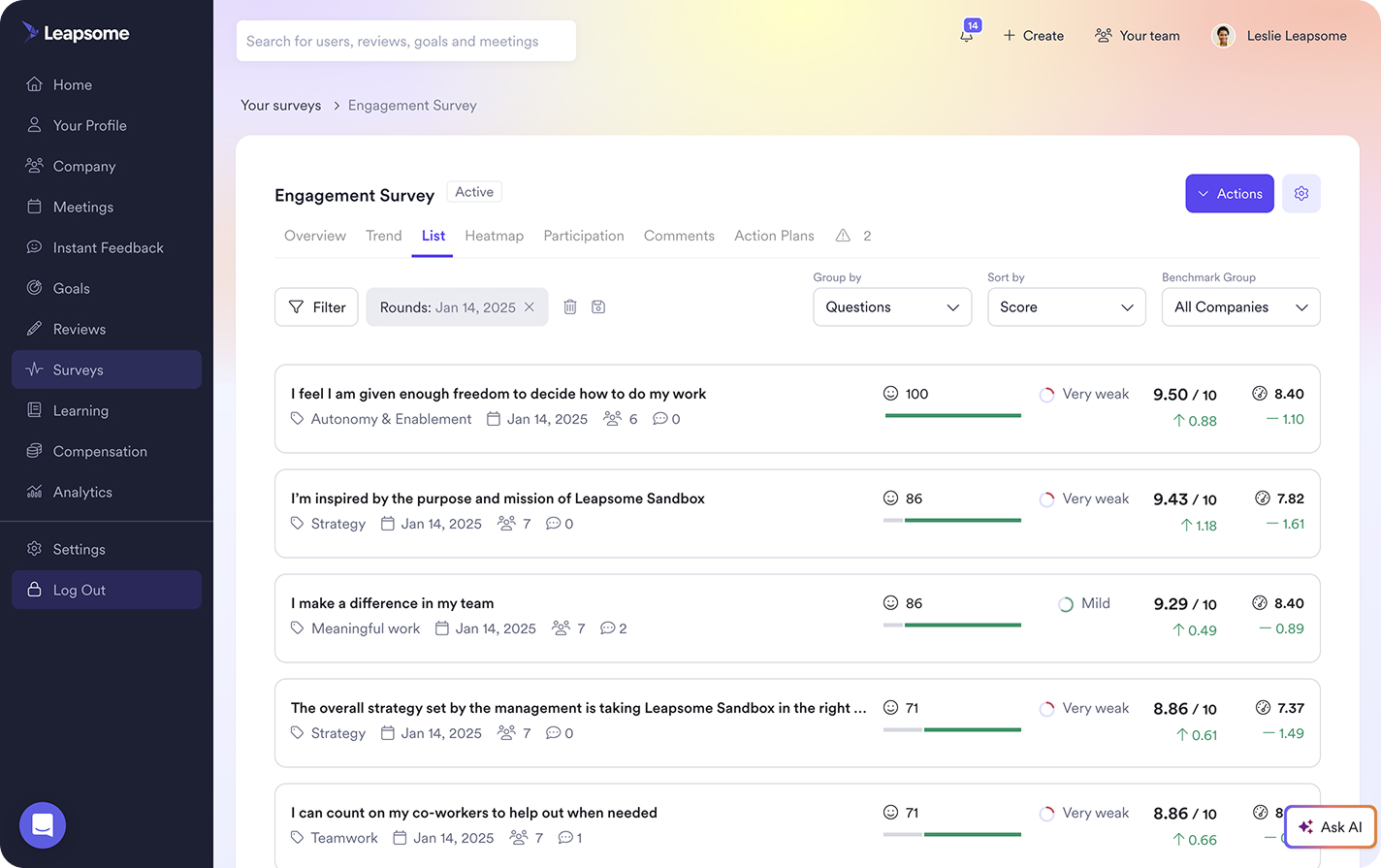AI adoption framework for HR teams: the ultimate guide

AI is reshaping work, but most organizations aren’t ready.
In Leapsome’s 2026 Workforce Trends Report — a survey of 2,400 respondents (HR leaders, managers, and individual contributors) — nearly two-thirds of respondents say they need stronger AI skills to keep pace with expectations. Yet fewer than one-third believe their company has a clear AI strategy, and only one in three employees feels prepared for AI’s impact on their role.
For HR and L&D leaders, this gap is both urgent and promising. Employees want structure, upskilling, and reassurance — and HR can lead the way, not by adding tools, but by preparing the workforce, shaping ethical implementation, and driving sustainable shifts.
This guide gives HR leaders a tactical AI adoption framework to move beyond the hype, manage expectations, and help their companies adopt AI with clarity and confidence.
📥 Download the AI adoption framework & checklist
Equip your HR team with a roadmap for responsible, organization-wide AI adoption.
👉 Get the free framework
Why HR should lead AI adoption
Many organizations approach AI like an IT-only rollout; they select tools, buy licenses, and expect productivity to rise. That approach stalls because AI is ultimately a people and process change.
HR is the only function that owns both at scale — from role design and performance to learning, workflows, and change management. That’s why AI adoption needs HR at the helm.
What happens when HR isn’t in the driver’s seat
- Pressure without support: According to the 2026 Workforce Trends Report, nearly two-thirds of respondents say they need stronger AI skills, yet fewer than one-third believe their company has a clear plan.
- Workflow friction: Teams bolt AI onto rigid processes, so time shifts from doing the work to fixing AI output.
- Trust erosion: Without clear guidance and guardrails, employees second-guess quality, privacy, and fairness.
What “HR leads” actually means
1. Translate ambition into roles & rituals
- Define who uses AI for what (by role) and how output quality is reviewed.
- Bake AI into existing rituals: 1:1s, sprint reviews, performance check-ins.
2. Build skills, not just access
- Launch role-based learning paths tied to real tasks (drafting feedback, summarizing meetings, refining goals).
- Enable managers to coach prompts, review outputs, and set realistic expectations.
3. Set visible guardrails
- Publish plain-language acceptable-use, data, and attribution policies.
- Establish a bias & quality review cadence and a simple escalation path (HR × Legal × Security).
4. Measure adoption before ROI
- Track adoption (training completions, weekly active AI users), then behaviors (% workflows with an AI step), then outcomes (cycle-time reduction, quality scores, eNPS).
Clear swimlanes: who owns what
- HR leads: role design, training paths, change plan, manager enablement, adoption metrics, comms
- IT & tool partners from each function: tool selection, integration, access, security
- Legal/Security: privacy, regulatory review, incident response sponsorship, resourcing, target setting
- Business leaders: sponsorship, resourcing, target setting
Manager behaviors that make AI stick
- Show, don’t tell: Demo your own prompt → output → review process.
- Coach continuously: In 1:1s, ask, “Where did AI help? Where did it hinder? What will we try next?”
- Right-size expectations: Set time-to-draft targets, reward learning speed and quality checks.
Anti-patterns to avoid
- Licenses before learning (access ≠ capability)
- New KPIs without redesign (unrealistic targets erode trust)
- Policy deeply hidden in a wiki (governance must be visible and simple)
💡 Bottom line: Executives set ambition; HR turns it into daily practice.
When HR leads, AI adoption aligns targets with capacity, builds trust through transparency, and converts tools into better work — not just busier work.
The 3 building blocks: AI adoption framework for HR + L&D teams
A structured approach is the difference between AI adoption that adds pressure and adoption that creates progress. The framework consists of three building blocks.
- Readiness: assess people, process, and data
- Governance: set and show clear guardrails
- Enablement: make AI use routine
Access our detailed framework and checklist below, and keep reading to learn more about these pillars.
🤖 Download our AI adoption framework
Give your HR team a roadmap to lead responsible, organization-wide AI adoption.
👉 Get the free framework

1. AI readiness assessment: check your starting point
Successful adoption starts with knowing where you stand today. An AI readiness assessment looks at the maturity of your people, processes, and data — the areas that decide whether new technology adds value or adds pressure.
- People: Half of employees say they need stronger AI skills to manage their current workload. Offer role-based upskilling tied to real tasks, and give managers coaching prompts to guide their teams.
- Process: Rigid targets and unclear workflows make AI feel like extra work. More than half of employees spend time fixing AI output; pilot, test, and adjust before scaling.
- Data: Fragmented or unreliable data creates rework. Prioritize data hygiene, governance, and clear access rules up front.
The AI maturity model (quick view)
You can frame these dimensions within a simple AI maturity model:
- Early stage: Minimal AI awareness, rigid processes, fragmented data, and ad-hoc experimentation without oversight.
- Maturing: Proof-of-concept projects underway, partial training, more flexible processes, improving data quality. Adoption is uneven across teams.
- AI-enabled: Structured learning paths, adaptive workflows, clean and governed data. AI is integrated into daily work with visible policies and manager support.
Self-check (fast)
- Do employees have role-specific training?
- Are workflows flexible enough to test and adjust?
- Is our data accurate and well-managed?
- Have we piloted one or two real use cases?
🧭 Find your AI readiness level
Map your current state against our maturity model and get tailored next steps for responsible adoption and growth.
👉 Take the AI readiness quiz
2. HR AI governance: set clear guardrails
Form a cross-functional group: Bring together HR, IT, L&D, Legal, and Data leaders. Each function has a clear role:
- IT ensures technical reliability, integrations, and security
- HR anchors adoption in roles, workflows, and culture
L&D designs learning paths and manager enablement - Legal reviews compliance, privacy, and ethics
- Data maintains quality, governance, and bias checks
Principles that matter
- Be transparent: Explain where and how AI is used
- Check for bias: Review outputs on a cadence
- Use ethically: Align with company values and employee trust
📊 Did you know?
76% of HR leaders say their company has an AI policy — but only 48% of employees agree. This gap shows why policies must be visible, practical, and easy to understand.
Make it visible
- Run regular tool/policy reviews
- Use a vetting checklist (bias, security/legal/legal/legal/legal/legal/privacy, usability, accessibility)
- Provide a clear channel to raise concerns (with SLA)
📣 Get a clear signal on AI use across teams
Pulse for real‑world AI practices, confidence, and concerns. Track trends by team and drive follow‑ups with owners and timelines.
👉 Explore Leapsome Surveys

3. AI enablement: make AI use routine
Tools don’t change behavior — consistent practice does. Design enablement so people can try AI in small, low-risk ways, get fast feedback, and apply it to real tasks.
Everyday practice ideas
- Prompt drills: Draft feedback, summarize meetings, refine goals
- Peer showcases: Early adopters demo real examples and answer questions
- 1:1 checkpoints: Managers review wins, friction points, and next steps
HR support system
- Microlearning: Short, role-based modules on demand
- Peer coaches: Internal champions for quick help
- Async resources: Guides and templates where people work
📚 Build role-based AI training with Leapsome Learning
Create structured training paths and track employee progress with confidence.
👉 Explore Leapsome Learning
.jpeg)
Measuring progress: don’t chase ROI too soon
Start with adoption, then behaviors, then outcomes. Set expectations accordingly.
- Adoption: training completions, # of pilots/POCs
- Behaviors: weekly active AI users, % workflows with an AI step
- Outcomes: time-to-draft reduction, quality scores, ENPS/engagement deltas
📊 52% of employees say leadership’s AI productivity expectations are unrealistic.
Calibrate goals to capability — measure usage and workflow change before outcome targets.
Common pitfalls in HR-led AI adoption (+ simple fixes)
- Rolling out tools without training → Pair every rollout with enablement
- Skipping risk checks → Add bias/legal/legal/legal/legal/legal/privacy checks before scale; review quarterly
- Chasing ROI too soon → Prove adoption and behaviors first
- Ignoring readiness → Assess people, process, data before buying more tools
- Weak investment case → Link AI to engagement, retention, cycle time, and quality
How Leapsome supports responsible AI adoption
Leapsome helps HR leaders prepare people, measure progress, and guide change at a sustainable pace:
- Learning: Structured, role‑based training paths with progress tracking and reminders, so managers and teams learn safe, effective AI use
- Surveys: Anonymous pulses on readiness, usage, confidence, and concerns, with heatmaps, drivers, and action plans
- Reviews: Reflect on AI‑related competencies and development inside performance cycles, with AI summaries and suggested next steps for managers
- Goals & OKRs: Make adoption milestones visible and accountable across teams, and track progress over time
- AI Copilot (Leapy): Help managers and admins work faster with insights, summaries, and best‑practice guidance — respecting role‑based permissions and not used for policy intake
💜 Support responsible AI adoption with Leapsome
Prepare your people, measure impact, and guide change at a sustainable pace.
👉 Explore Leapsome AI
Kickstart checklist (print-friendly)
- Run a readiness audit (people, process, data)
- Stand up a governance group (HR, IT, L&D, Legal, Data)
- Pilot 2-3 everyday use cases with success criteria
- Launch role-based AI training in your LMS
- Track adoption via Goals, Reviews & Surveys
👟 Kickstart AI adoption with Leapsome
Train employees, measure readiness, and track progress — all in one place.
👉 Explore how Leapsome supports AI readiness
FAQ
What is an AI adoption framework?
An AI adoption framework is a structured roadmap that guides organizations through integrating AI into their operations — from readiness and governance to rollout and measurement.
Why does HR’s role matter in an AI adoption framework?
HR connects technology to people and processes. In the context of AI adoption, HR ensures that tools are supported with training, clear workflows, fairness principles, and role-based accountability.
How do we measure progress within an AI adoption framework?
Start with adoption metrics (training completions, pilot launches), then behavior metrics (active users, % workflows using AI), and only then outcomes (time saved, quality improvements, engagement impact).
🔬 All statistics referenced are from Leapsome’s 2026 Workforce Trends Report
⚖️ Legal note: This guide is for informational purposes only and isn’t legal advice. For compliance decisions, consult legal counsel and regional guidance.
Verwandte Artikel
Zurück zum BlogSind Sie bereit, Ihre Strategie zur Mitarbeiterförderung zu verbessern?
your People operations?
Informieren Sie sich über unsere Leistungsbeurteilungen, Ziele und OKRs, Engagement-Umfragen, Onboarding und mehr.
.webp)
.webp)
 Fordern Sie noch heute eine Demo an
Fordern Sie noch heute eine Demo an































